Recruitment Challenges and Strategies for ALDI's Human Resources
VerifiedAdded on 2020/03/23
|10
|2884
|119
Report
AI Summary
This report provides an analysis of the recruitment challenges faced by ALDI, a well-known supermarket chain. It begins with an executive summary and introduction, highlighting the importance of an effective recruitment process for organizational growth. The report identifies five major recruitment challenges: growing cultural diversity, intense competition, organizational image, labor shortages, and the generation gap/ageing workforce. Each challenge is explored in detail, providing context and examples. The report then offers five recommended strategies to overcome these challenges, including cross-cultural training, employer branding, improving organizational image, enhancing recruitment plans, and addressing generation gaps. The conclusion reiterates the significance of recruitment and the proposed strategies, emphasizing their potential to improve ALDI's hiring processes and overall success. References are also included to support the research and findings presented in the report.

Running head: Managing Human Resources 1
Paraphrase This Document
Need a fresh take? Get an instant paraphrase of this document with our AI Paraphraser
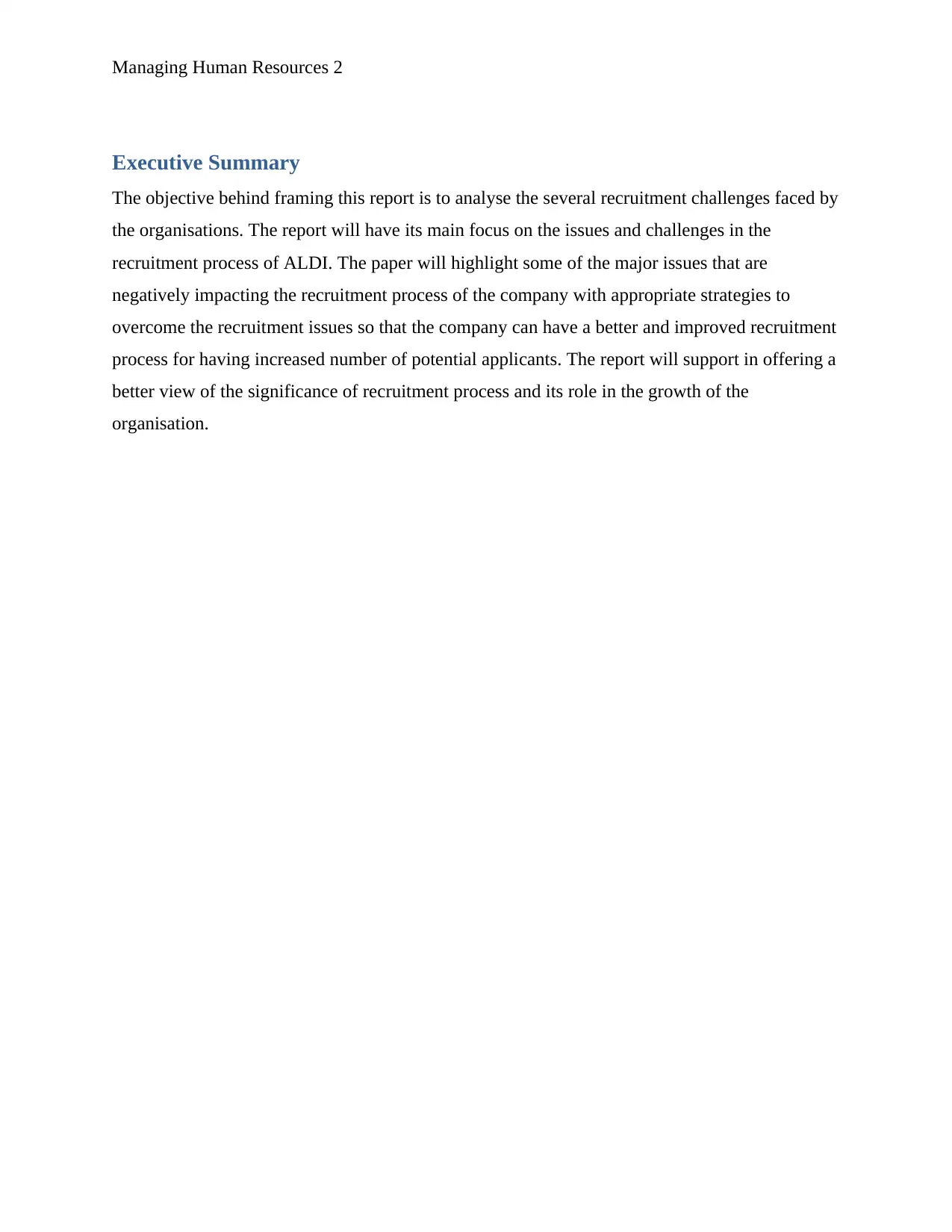
Managing Human Resources 2
Executive Summary
The objective behind framing this report is to analyse the several recruitment challenges faced by
the organisations. The report will have its main focus on the issues and challenges in the
recruitment process of ALDI. The paper will highlight some of the major issues that are
negatively impacting the recruitment process of the company with appropriate strategies to
overcome the recruitment issues so that the company can have a better and improved recruitment
process for having increased number of potential applicants. The report will support in offering a
better view of the significance of recruitment process and its role in the growth of the
organisation.
Executive Summary
The objective behind framing this report is to analyse the several recruitment challenges faced by
the organisations. The report will have its main focus on the issues and challenges in the
recruitment process of ALDI. The paper will highlight some of the major issues that are
negatively impacting the recruitment process of the company with appropriate strategies to
overcome the recruitment issues so that the company can have a better and improved recruitment
process for having increased number of potential applicants. The report will support in offering a
better view of the significance of recruitment process and its role in the growth of the
organisation.
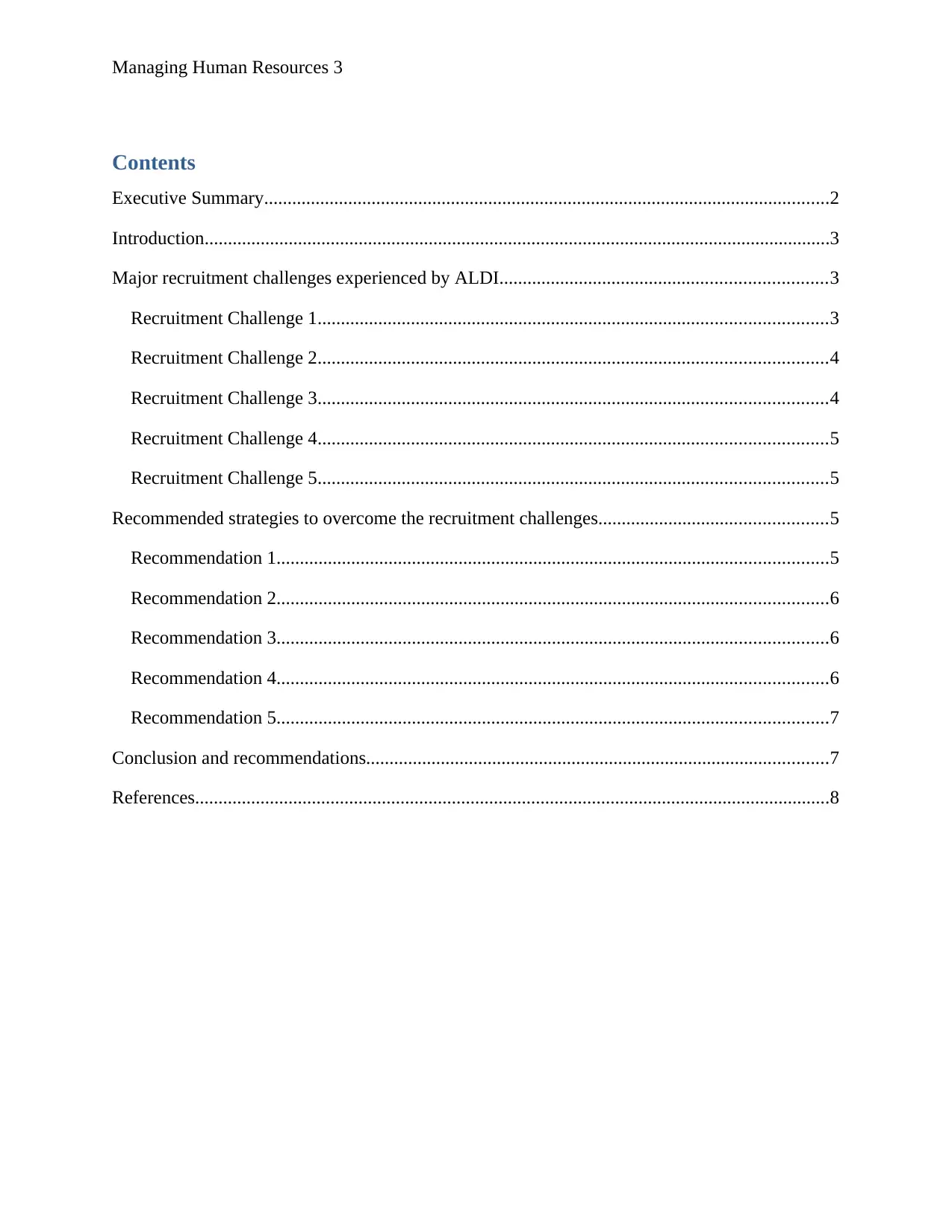
Managing Human Resources 3
Contents
Executive Summary.........................................................................................................................2
Introduction......................................................................................................................................3
Major recruitment challenges experienced by ALDI......................................................................3
Recruitment Challenge 1.............................................................................................................3
Recruitment Challenge 2.............................................................................................................4
Recruitment Challenge 3.............................................................................................................4
Recruitment Challenge 4.............................................................................................................5
Recruitment Challenge 5.............................................................................................................5
Recommended strategies to overcome the recruitment challenges.................................................5
Recommendation 1......................................................................................................................5
Recommendation 2......................................................................................................................6
Recommendation 3......................................................................................................................6
Recommendation 4......................................................................................................................6
Recommendation 5......................................................................................................................7
Conclusion and recommendations...................................................................................................7
References........................................................................................................................................8
Contents
Executive Summary.........................................................................................................................2
Introduction......................................................................................................................................3
Major recruitment challenges experienced by ALDI......................................................................3
Recruitment Challenge 1.............................................................................................................3
Recruitment Challenge 2.............................................................................................................4
Recruitment Challenge 3.............................................................................................................4
Recruitment Challenge 4.............................................................................................................5
Recruitment Challenge 5.............................................................................................................5
Recommended strategies to overcome the recruitment challenges.................................................5
Recommendation 1......................................................................................................................5
Recommendation 2......................................................................................................................6
Recommendation 3......................................................................................................................6
Recommendation 4......................................................................................................................6
Recommendation 5......................................................................................................................7
Conclusion and recommendations...................................................................................................7
References........................................................................................................................................8
⊘ This is a preview!⊘
Do you want full access?
Subscribe today to unlock all pages.

Trusted by 1+ million students worldwide
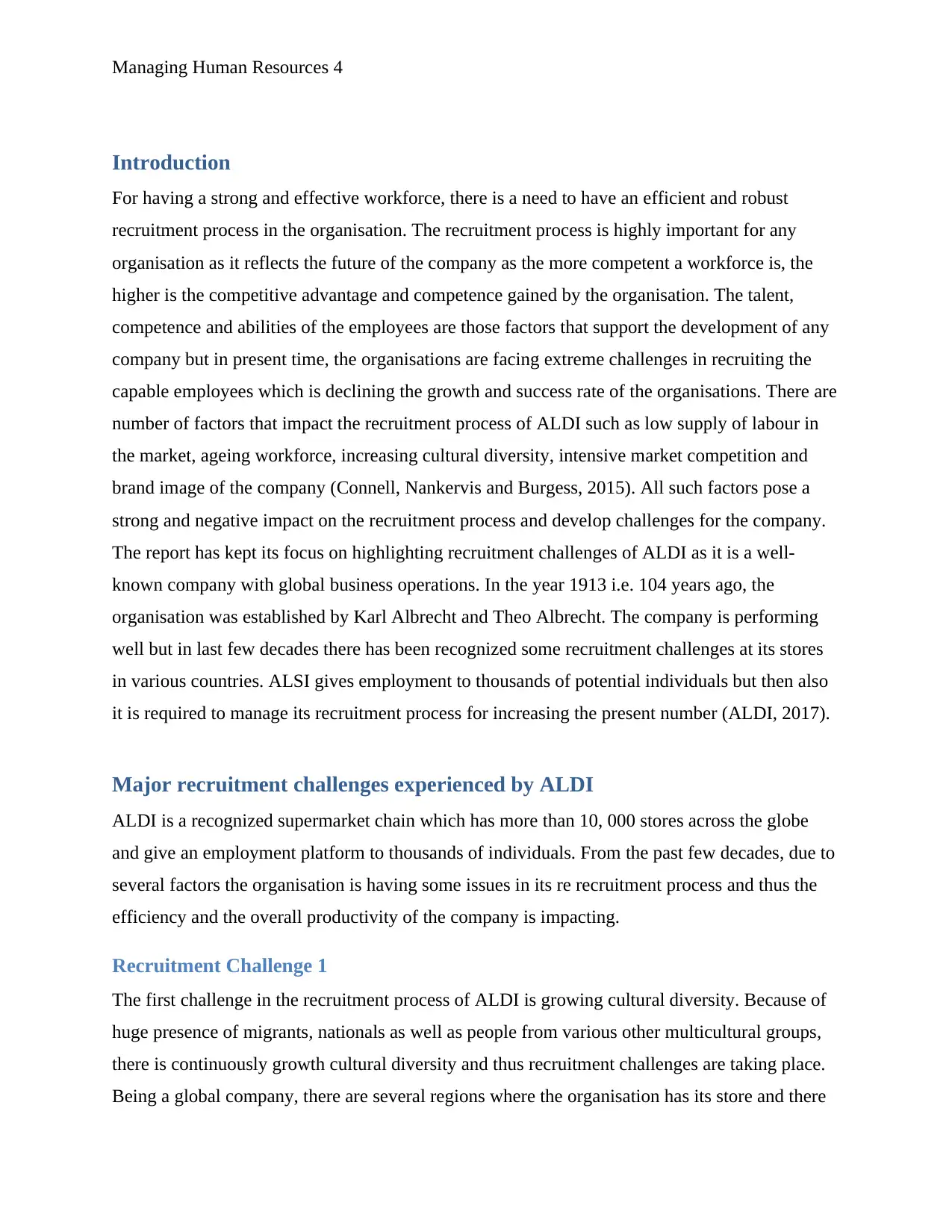
Managing Human Resources 4
Introduction
For having a strong and effective workforce, there is a need to have an efficient and robust
recruitment process in the organisation. The recruitment process is highly important for any
organisation as it reflects the future of the company as the more competent a workforce is, the
higher is the competitive advantage and competence gained by the organisation. The talent,
competence and abilities of the employees are those factors that support the development of any
company but in present time, the organisations are facing extreme challenges in recruiting the
capable employees which is declining the growth and success rate of the organisations. There are
number of factors that impact the recruitment process of ALDI such as low supply of labour in
the market, ageing workforce, increasing cultural diversity, intensive market competition and
brand image of the company (Connell, Nankervis and Burgess, 2015). All such factors pose a
strong and negative impact on the recruitment process and develop challenges for the company.
The report has kept its focus on highlighting recruitment challenges of ALDI as it is a well-
known company with global business operations. In the year 1913 i.e. 104 years ago, the
organisation was established by Karl Albrecht and Theo Albrecht. The company is performing
well but in last few decades there has been recognized some recruitment challenges at its stores
in various countries. ALSI gives employment to thousands of potential individuals but then also
it is required to manage its recruitment process for increasing the present number (ALDI, 2017).
Major recruitment challenges experienced by ALDI
ALDI is a recognized supermarket chain which has more than 10, 000 stores across the globe
and give an employment platform to thousands of individuals. From the past few decades, due to
several factors the organisation is having some issues in its re recruitment process and thus the
efficiency and the overall productivity of the company is impacting.
Recruitment Challenge 1
The first challenge in the recruitment process of ALDI is growing cultural diversity. Because of
huge presence of migrants, nationals as well as people from various other multicultural groups,
there is continuously growth cultural diversity and thus recruitment challenges are taking place.
Being a global company, there are several regions where the organisation has its store and there
Introduction
For having a strong and effective workforce, there is a need to have an efficient and robust
recruitment process in the organisation. The recruitment process is highly important for any
organisation as it reflects the future of the company as the more competent a workforce is, the
higher is the competitive advantage and competence gained by the organisation. The talent,
competence and abilities of the employees are those factors that support the development of any
company but in present time, the organisations are facing extreme challenges in recruiting the
capable employees which is declining the growth and success rate of the organisations. There are
number of factors that impact the recruitment process of ALDI such as low supply of labour in
the market, ageing workforce, increasing cultural diversity, intensive market competition and
brand image of the company (Connell, Nankervis and Burgess, 2015). All such factors pose a
strong and negative impact on the recruitment process and develop challenges for the company.
The report has kept its focus on highlighting recruitment challenges of ALDI as it is a well-
known company with global business operations. In the year 1913 i.e. 104 years ago, the
organisation was established by Karl Albrecht and Theo Albrecht. The company is performing
well but in last few decades there has been recognized some recruitment challenges at its stores
in various countries. ALSI gives employment to thousands of potential individuals but then also
it is required to manage its recruitment process for increasing the present number (ALDI, 2017).
Major recruitment challenges experienced by ALDI
ALDI is a recognized supermarket chain which has more than 10, 000 stores across the globe
and give an employment platform to thousands of individuals. From the past few decades, due to
several factors the organisation is having some issues in its re recruitment process and thus the
efficiency and the overall productivity of the company is impacting.
Recruitment Challenge 1
The first challenge in the recruitment process of ALDI is growing cultural diversity. Because of
huge presence of migrants, nationals as well as people from various other multicultural groups,
there is continuously growth cultural diversity and thus recruitment challenges are taking place.
Being a global company, there are several regions where the organisation has its store and there
Paraphrase This Document
Need a fresh take? Get an instant paraphrase of this document with our AI Paraphraser
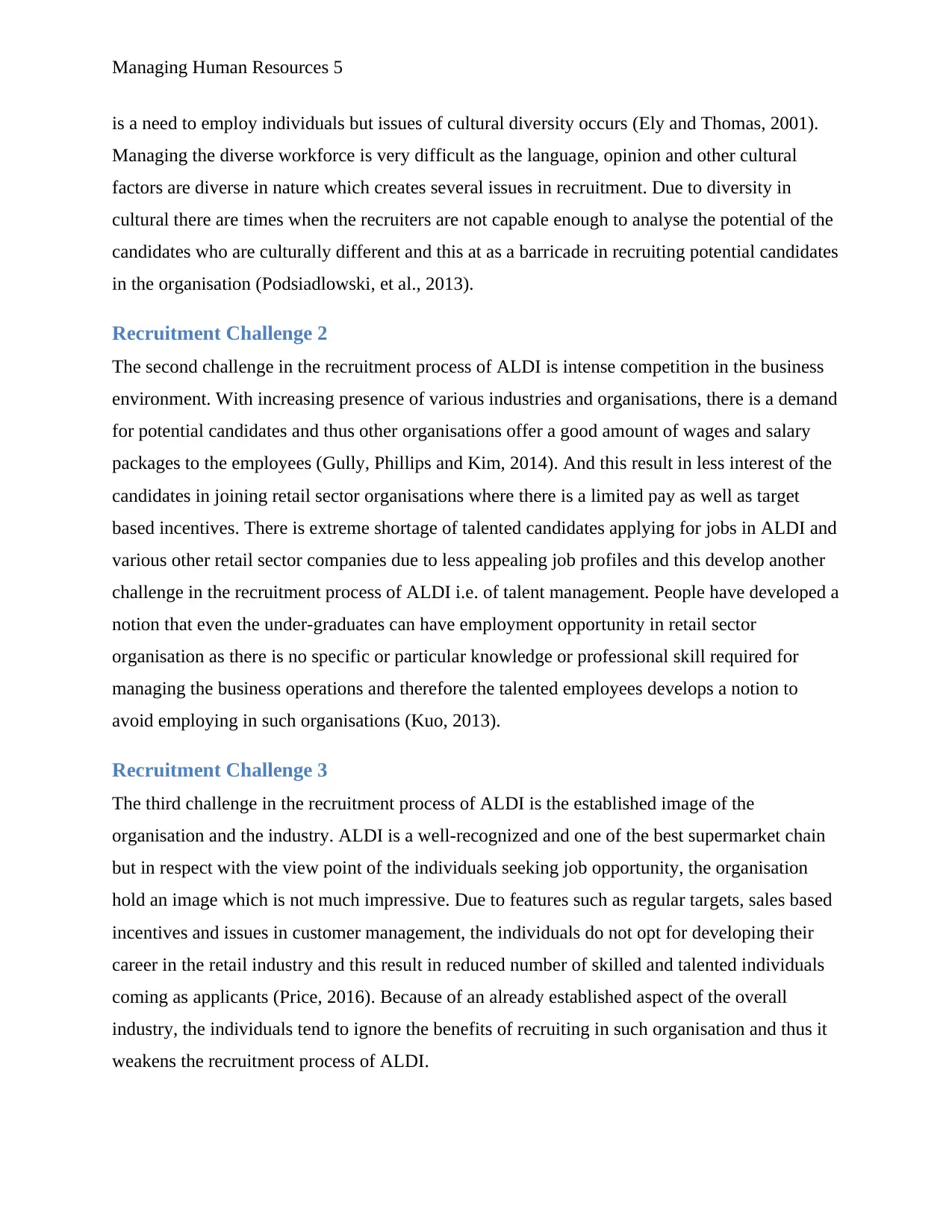
Managing Human Resources 5
is a need to employ individuals but issues of cultural diversity occurs (Ely and Thomas, 2001).
Managing the diverse workforce is very difficult as the language, opinion and other cultural
factors are diverse in nature which creates several issues in recruitment. Due to diversity in
cultural there are times when the recruiters are not capable enough to analyse the potential of the
candidates who are culturally different and this at as a barricade in recruiting potential candidates
in the organisation (Podsiadlowski, et al., 2013).
Recruitment Challenge 2
The second challenge in the recruitment process of ALDI is intense competition in the business
environment. With increasing presence of various industries and organisations, there is a demand
for potential candidates and thus other organisations offer a good amount of wages and salary
packages to the employees (Gully, Phillips and Kim, 2014). And this result in less interest of the
candidates in joining retail sector organisations where there is a limited pay as well as target
based incentives. There is extreme shortage of talented candidates applying for jobs in ALDI and
various other retail sector companies due to less appealing job profiles and this develop another
challenge in the recruitment process of ALDI i.e. of talent management. People have developed a
notion that even the under-graduates can have employment opportunity in retail sector
organisation as there is no specific or particular knowledge or professional skill required for
managing the business operations and therefore the talented employees develops a notion to
avoid employing in such organisations (Kuo, 2013).
Recruitment Challenge 3
The third challenge in the recruitment process of ALDI is the established image of the
organisation and the industry. ALDI is a well-recognized and one of the best supermarket chain
but in respect with the view point of the individuals seeking job opportunity, the organisation
hold an image which is not much impressive. Due to features such as regular targets, sales based
incentives and issues in customer management, the individuals do not opt for developing their
career in the retail industry and this result in reduced number of skilled and talented individuals
coming as applicants (Price, 2016). Because of an already established aspect of the overall
industry, the individuals tend to ignore the benefits of recruiting in such organisation and thus it
weakens the recruitment process of ALDI.
is a need to employ individuals but issues of cultural diversity occurs (Ely and Thomas, 2001).
Managing the diverse workforce is very difficult as the language, opinion and other cultural
factors are diverse in nature which creates several issues in recruitment. Due to diversity in
cultural there are times when the recruiters are not capable enough to analyse the potential of the
candidates who are culturally different and this at as a barricade in recruiting potential candidates
in the organisation (Podsiadlowski, et al., 2013).
Recruitment Challenge 2
The second challenge in the recruitment process of ALDI is intense competition in the business
environment. With increasing presence of various industries and organisations, there is a demand
for potential candidates and thus other organisations offer a good amount of wages and salary
packages to the employees (Gully, Phillips and Kim, 2014). And this result in less interest of the
candidates in joining retail sector organisations where there is a limited pay as well as target
based incentives. There is extreme shortage of talented candidates applying for jobs in ALDI and
various other retail sector companies due to less appealing job profiles and this develop another
challenge in the recruitment process of ALDI i.e. of talent management. People have developed a
notion that even the under-graduates can have employment opportunity in retail sector
organisation as there is no specific or particular knowledge or professional skill required for
managing the business operations and therefore the talented employees develops a notion to
avoid employing in such organisations (Kuo, 2013).
Recruitment Challenge 3
The third challenge in the recruitment process of ALDI is the established image of the
organisation and the industry. ALDI is a well-recognized and one of the best supermarket chain
but in respect with the view point of the individuals seeking job opportunity, the organisation
hold an image which is not much impressive. Due to features such as regular targets, sales based
incentives and issues in customer management, the individuals do not opt for developing their
career in the retail industry and this result in reduced number of skilled and talented individuals
coming as applicants (Price, 2016). Because of an already established aspect of the overall
industry, the individuals tend to ignore the benefits of recruiting in such organisation and thus it
weakens the recruitment process of ALDI.
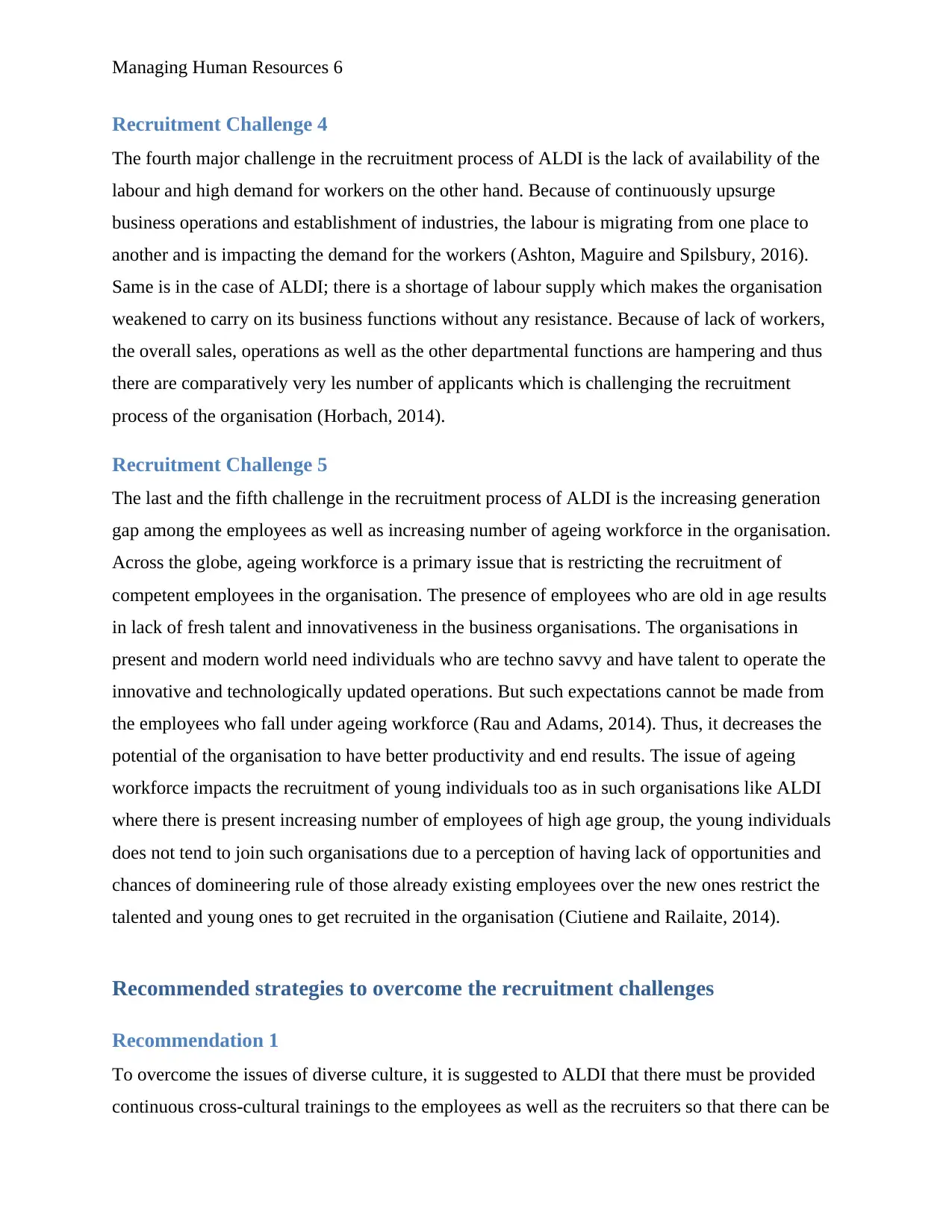
Managing Human Resources 6
Recruitment Challenge 4
The fourth major challenge in the recruitment process of ALDI is the lack of availability of the
labour and high demand for workers on the other hand. Because of continuously upsurge
business operations and establishment of industries, the labour is migrating from one place to
another and is impacting the demand for the workers (Ashton, Maguire and Spilsbury, 2016).
Same is in the case of ALDI; there is a shortage of labour supply which makes the organisation
weakened to carry on its business functions without any resistance. Because of lack of workers,
the overall sales, operations as well as the other departmental functions are hampering and thus
there are comparatively very les number of applicants which is challenging the recruitment
process of the organisation (Horbach, 2014).
Recruitment Challenge 5
The last and the fifth challenge in the recruitment process of ALDI is the increasing generation
gap among the employees as well as increasing number of ageing workforce in the organisation.
Across the globe, ageing workforce is a primary issue that is restricting the recruitment of
competent employees in the organisation. The presence of employees who are old in age results
in lack of fresh talent and innovativeness in the business organisations. The organisations in
present and modern world need individuals who are techno savvy and have talent to operate the
innovative and technologically updated operations. But such expectations cannot be made from
the employees who fall under ageing workforce (Rau and Adams, 2014). Thus, it decreases the
potential of the organisation to have better productivity and end results. The issue of ageing
workforce impacts the recruitment of young individuals too as in such organisations like ALDI
where there is present increasing number of employees of high age group, the young individuals
does not tend to join such organisations due to a perception of having lack of opportunities and
chances of domineering rule of those already existing employees over the new ones restrict the
talented and young ones to get recruited in the organisation (Ciutiene and Railaite, 2014).
Recommended strategies to overcome the recruitment challenges
Recommendation 1
To overcome the issues of diverse culture, it is suggested to ALDI that there must be provided
continuous cross-cultural trainings to the employees as well as the recruiters so that there can be
Recruitment Challenge 4
The fourth major challenge in the recruitment process of ALDI is the lack of availability of the
labour and high demand for workers on the other hand. Because of continuously upsurge
business operations and establishment of industries, the labour is migrating from one place to
another and is impacting the demand for the workers (Ashton, Maguire and Spilsbury, 2016).
Same is in the case of ALDI; there is a shortage of labour supply which makes the organisation
weakened to carry on its business functions without any resistance. Because of lack of workers,
the overall sales, operations as well as the other departmental functions are hampering and thus
there are comparatively very les number of applicants which is challenging the recruitment
process of the organisation (Horbach, 2014).
Recruitment Challenge 5
The last and the fifth challenge in the recruitment process of ALDI is the increasing generation
gap among the employees as well as increasing number of ageing workforce in the organisation.
Across the globe, ageing workforce is a primary issue that is restricting the recruitment of
competent employees in the organisation. The presence of employees who are old in age results
in lack of fresh talent and innovativeness in the business organisations. The organisations in
present and modern world need individuals who are techno savvy and have talent to operate the
innovative and technologically updated operations. But such expectations cannot be made from
the employees who fall under ageing workforce (Rau and Adams, 2014). Thus, it decreases the
potential of the organisation to have better productivity and end results. The issue of ageing
workforce impacts the recruitment of young individuals too as in such organisations like ALDI
where there is present increasing number of employees of high age group, the young individuals
does not tend to join such organisations due to a perception of having lack of opportunities and
chances of domineering rule of those already existing employees over the new ones restrict the
talented and young ones to get recruited in the organisation (Ciutiene and Railaite, 2014).
Recommended strategies to overcome the recruitment challenges
Recommendation 1
To overcome the issues of diverse culture, it is suggested to ALDI that there must be provided
continuous cross-cultural trainings to the employees as well as the recruiters so that there can be
⊘ This is a preview!⊘
Do you want full access?
Subscribe today to unlock all pages.

Trusted by 1+ million students worldwide
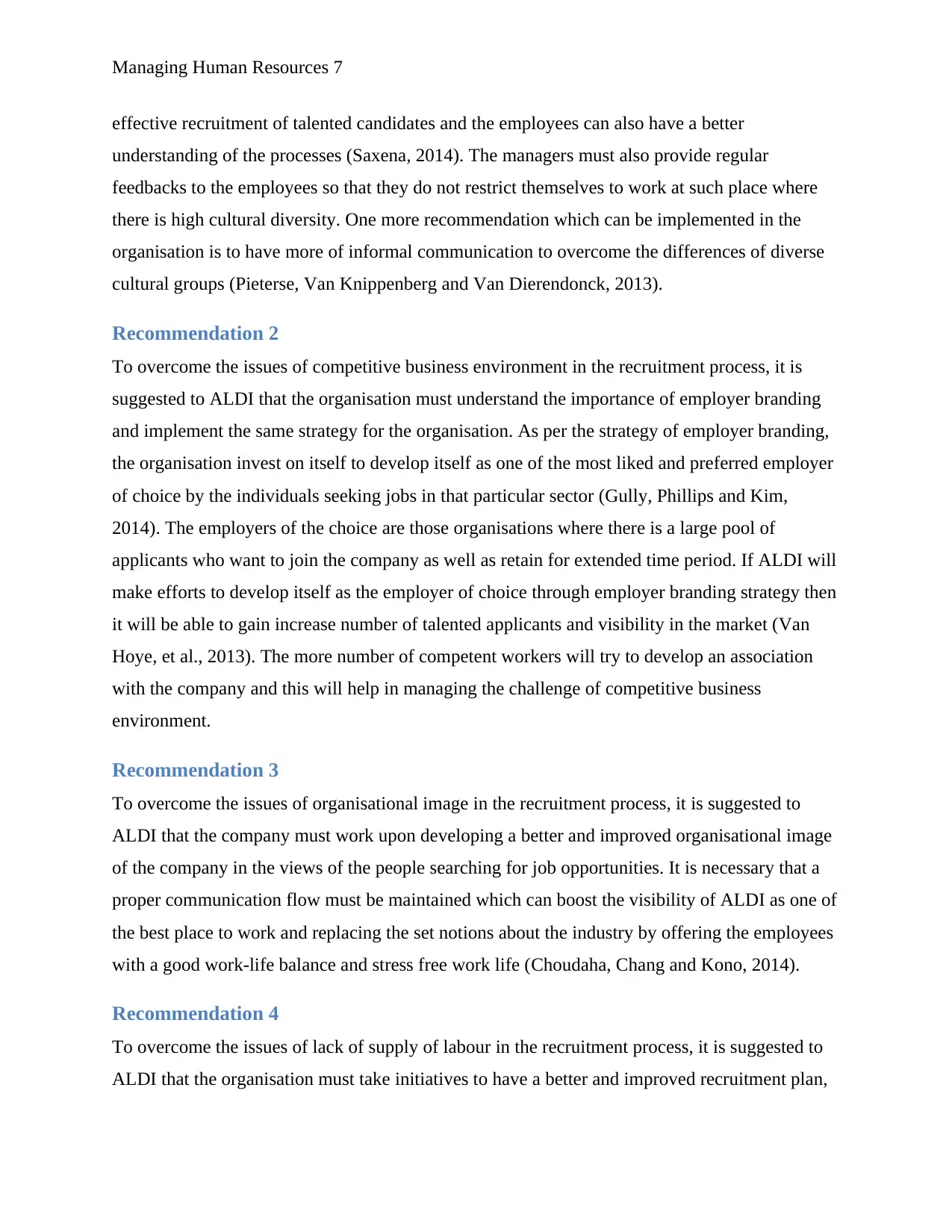
Managing Human Resources 7
effective recruitment of talented candidates and the employees can also have a better
understanding of the processes (Saxena, 2014). The managers must also provide regular
feedbacks to the employees so that they do not restrict themselves to work at such place where
there is high cultural diversity. One more recommendation which can be implemented in the
organisation is to have more of informal communication to overcome the differences of diverse
cultural groups (Pieterse, Van Knippenberg and Van Dierendonck, 2013).
Recommendation 2
To overcome the issues of competitive business environment in the recruitment process, it is
suggested to ALDI that the organisation must understand the importance of employer branding
and implement the same strategy for the organisation. As per the strategy of employer branding,
the organisation invest on itself to develop itself as one of the most liked and preferred employer
of choice by the individuals seeking jobs in that particular sector (Gully, Phillips and Kim,
2014). The employers of the choice are those organisations where there is a large pool of
applicants who want to join the company as well as retain for extended time period. If ALDI will
make efforts to develop itself as the employer of choice through employer branding strategy then
it will be able to gain increase number of talented applicants and visibility in the market (Van
Hoye, et al., 2013). The more number of competent workers will try to develop an association
with the company and this will help in managing the challenge of competitive business
environment.
Recommendation 3
To overcome the issues of organisational image in the recruitment process, it is suggested to
ALDI that the company must work upon developing a better and improved organisational image
of the company in the views of the people searching for job opportunities. It is necessary that a
proper communication flow must be maintained which can boost the visibility of ALDI as one of
the best place to work and replacing the set notions about the industry by offering the employees
with a good work-life balance and stress free work life (Choudaha, Chang and Kono, 2014).
Recommendation 4
To overcome the issues of lack of supply of labour in the recruitment process, it is suggested to
ALDI that the organisation must take initiatives to have a better and improved recruitment plan,
effective recruitment of talented candidates and the employees can also have a better
understanding of the processes (Saxena, 2014). The managers must also provide regular
feedbacks to the employees so that they do not restrict themselves to work at such place where
there is high cultural diversity. One more recommendation which can be implemented in the
organisation is to have more of informal communication to overcome the differences of diverse
cultural groups (Pieterse, Van Knippenberg and Van Dierendonck, 2013).
Recommendation 2
To overcome the issues of competitive business environment in the recruitment process, it is
suggested to ALDI that the organisation must understand the importance of employer branding
and implement the same strategy for the organisation. As per the strategy of employer branding,
the organisation invest on itself to develop itself as one of the most liked and preferred employer
of choice by the individuals seeking jobs in that particular sector (Gully, Phillips and Kim,
2014). The employers of the choice are those organisations where there is a large pool of
applicants who want to join the company as well as retain for extended time period. If ALDI will
make efforts to develop itself as the employer of choice through employer branding strategy then
it will be able to gain increase number of talented applicants and visibility in the market (Van
Hoye, et al., 2013). The more number of competent workers will try to develop an association
with the company and this will help in managing the challenge of competitive business
environment.
Recommendation 3
To overcome the issues of organisational image in the recruitment process, it is suggested to
ALDI that the company must work upon developing a better and improved organisational image
of the company in the views of the people searching for job opportunities. It is necessary that a
proper communication flow must be maintained which can boost the visibility of ALDI as one of
the best place to work and replacing the set notions about the industry by offering the employees
with a good work-life balance and stress free work life (Choudaha, Chang and Kono, 2014).
Recommendation 4
To overcome the issues of lack of supply of labour in the recruitment process, it is suggested to
ALDI that the organisation must take initiatives to have a better and improved recruitment plan,
Paraphrase This Document
Need a fresh take? Get an instant paraphrase of this document with our AI Paraphraser
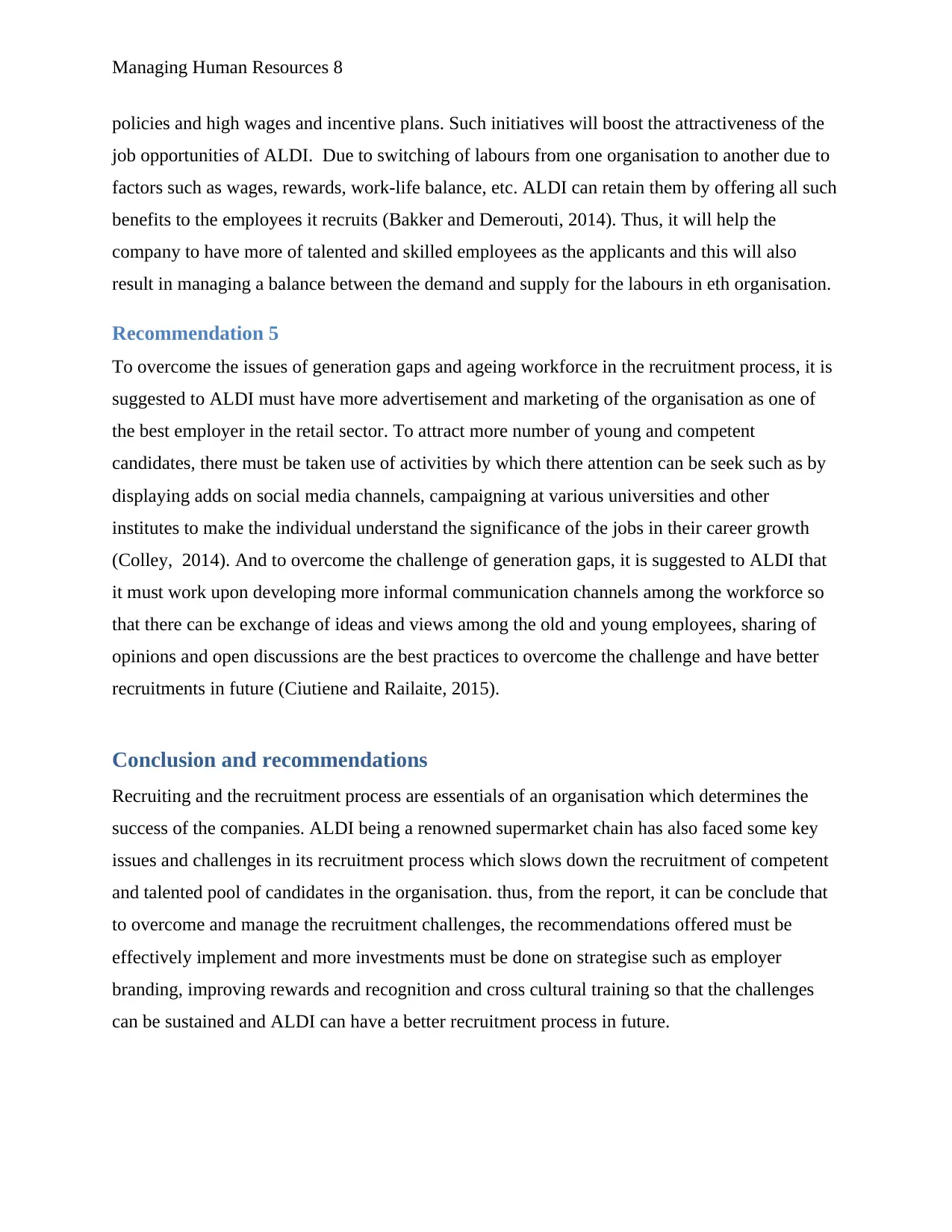
Managing Human Resources 8
policies and high wages and incentive plans. Such initiatives will boost the attractiveness of the
job opportunities of ALDI. Due to switching of labours from one organisation to another due to
factors such as wages, rewards, work-life balance, etc. ALDI can retain them by offering all such
benefits to the employees it recruits (Bakker and Demerouti, 2014). Thus, it will help the
company to have more of talented and skilled employees as the applicants and this will also
result in managing a balance between the demand and supply for the labours in eth organisation.
Recommendation 5
To overcome the issues of generation gaps and ageing workforce in the recruitment process, it is
suggested to ALDI must have more advertisement and marketing of the organisation as one of
the best employer in the retail sector. To attract more number of young and competent
candidates, there must be taken use of activities by which there attention can be seek such as by
displaying adds on social media channels, campaigning at various universities and other
institutes to make the individual understand the significance of the jobs in their career growth
(Colley, 2014). And to overcome the challenge of generation gaps, it is suggested to ALDI that
it must work upon developing more informal communication channels among the workforce so
that there can be exchange of ideas and views among the old and young employees, sharing of
opinions and open discussions are the best practices to overcome the challenge and have better
recruitments in future (Ciutiene and Railaite, 2015).
Conclusion and recommendations
Recruiting and the recruitment process are essentials of an organisation which determines the
success of the companies. ALDI being a renowned supermarket chain has also faced some key
issues and challenges in its recruitment process which slows down the recruitment of competent
and talented pool of candidates in the organisation. thus, from the report, it can be conclude that
to overcome and manage the recruitment challenges, the recommendations offered must be
effectively implement and more investments must be done on strategise such as employer
branding, improving rewards and recognition and cross cultural training so that the challenges
can be sustained and ALDI can have a better recruitment process in future.
policies and high wages and incentive plans. Such initiatives will boost the attractiveness of the
job opportunities of ALDI. Due to switching of labours from one organisation to another due to
factors such as wages, rewards, work-life balance, etc. ALDI can retain them by offering all such
benefits to the employees it recruits (Bakker and Demerouti, 2014). Thus, it will help the
company to have more of talented and skilled employees as the applicants and this will also
result in managing a balance between the demand and supply for the labours in eth organisation.
Recommendation 5
To overcome the issues of generation gaps and ageing workforce in the recruitment process, it is
suggested to ALDI must have more advertisement and marketing of the organisation as one of
the best employer in the retail sector. To attract more number of young and competent
candidates, there must be taken use of activities by which there attention can be seek such as by
displaying adds on social media channels, campaigning at various universities and other
institutes to make the individual understand the significance of the jobs in their career growth
(Colley, 2014). And to overcome the challenge of generation gaps, it is suggested to ALDI that
it must work upon developing more informal communication channels among the workforce so
that there can be exchange of ideas and views among the old and young employees, sharing of
opinions and open discussions are the best practices to overcome the challenge and have better
recruitments in future (Ciutiene and Railaite, 2015).
Conclusion and recommendations
Recruiting and the recruitment process are essentials of an organisation which determines the
success of the companies. ALDI being a renowned supermarket chain has also faced some key
issues and challenges in its recruitment process which slows down the recruitment of competent
and talented pool of candidates in the organisation. thus, from the report, it can be conclude that
to overcome and manage the recruitment challenges, the recommendations offered must be
effectively implement and more investments must be done on strategise such as employer
branding, improving rewards and recognition and cross cultural training so that the challenges
can be sustained and ALDI can have a better recruitment process in future.
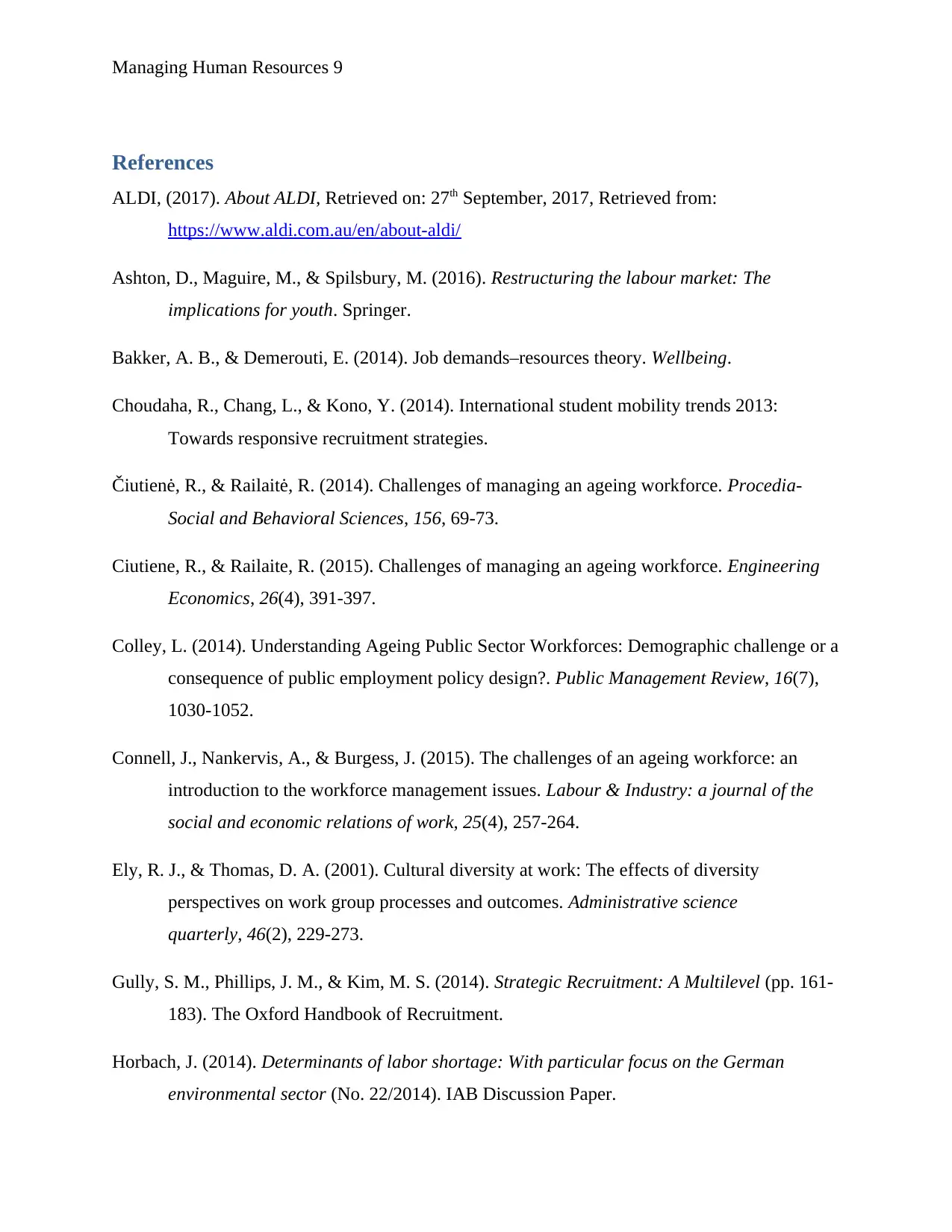
Managing Human Resources 9
References
ALDI, (2017). About ALDI, Retrieved on: 27th September, 2017, Retrieved from:
https://www.aldi.com.au/en/about-aldi/
Ashton, D., Maguire, M., & Spilsbury, M. (2016). Restructuring the labour market: The
implications for youth. Springer.
Bakker, A. B., & Demerouti, E. (2014). Job demands–resources theory. Wellbeing.
Choudaha, R., Chang, L., & Kono, Y. (2014). International student mobility trends 2013:
Towards responsive recruitment strategies.
Čiutienė, R., & Railaitė, R. (2014). Challenges of managing an ageing workforce. Procedia-
Social and Behavioral Sciences, 156, 69-73.
Ciutiene, R., & Railaite, R. (2015). Challenges of managing an ageing workforce. Engineering
Economics, 26(4), 391-397.
Colley, L. (2014). Understanding Ageing Public Sector Workforces: Demographic challenge or a
consequence of public employment policy design?. Public Management Review, 16(7),
1030-1052.
Connell, J., Nankervis, A., & Burgess, J. (2015). The challenges of an ageing workforce: an
introduction to the workforce management issues. Labour & Industry: a journal of the
social and economic relations of work, 25(4), 257-264.
Ely, R. J., & Thomas, D. A. (2001). Cultural diversity at work: The effects of diversity
perspectives on work group processes and outcomes. Administrative science
quarterly, 46(2), 229-273.
Gully, S. M., Phillips, J. M., & Kim, M. S. (2014). Strategic Recruitment: A Multilevel (pp. 161-
183). The Oxford Handbook of Recruitment.
Horbach, J. (2014). Determinants of labor shortage: With particular focus on the German
environmental sector (No. 22/2014). IAB Discussion Paper.
References
ALDI, (2017). About ALDI, Retrieved on: 27th September, 2017, Retrieved from:
https://www.aldi.com.au/en/about-aldi/
Ashton, D., Maguire, M., & Spilsbury, M. (2016). Restructuring the labour market: The
implications for youth. Springer.
Bakker, A. B., & Demerouti, E. (2014). Job demands–resources theory. Wellbeing.
Choudaha, R., Chang, L., & Kono, Y. (2014). International student mobility trends 2013:
Towards responsive recruitment strategies.
Čiutienė, R., & Railaitė, R. (2014). Challenges of managing an ageing workforce. Procedia-
Social and Behavioral Sciences, 156, 69-73.
Ciutiene, R., & Railaite, R. (2015). Challenges of managing an ageing workforce. Engineering
Economics, 26(4), 391-397.
Colley, L. (2014). Understanding Ageing Public Sector Workforces: Demographic challenge or a
consequence of public employment policy design?. Public Management Review, 16(7),
1030-1052.
Connell, J., Nankervis, A., & Burgess, J. (2015). The challenges of an ageing workforce: an
introduction to the workforce management issues. Labour & Industry: a journal of the
social and economic relations of work, 25(4), 257-264.
Ely, R. J., & Thomas, D. A. (2001). Cultural diversity at work: The effects of diversity
perspectives on work group processes and outcomes. Administrative science
quarterly, 46(2), 229-273.
Gully, S. M., Phillips, J. M., & Kim, M. S. (2014). Strategic Recruitment: A Multilevel (pp. 161-
183). The Oxford Handbook of Recruitment.
Horbach, J. (2014). Determinants of labor shortage: With particular focus on the German
environmental sector (No. 22/2014). IAB Discussion Paper.
⊘ This is a preview!⊘
Do you want full access?
Subscribe today to unlock all pages.

Trusted by 1+ million students worldwide
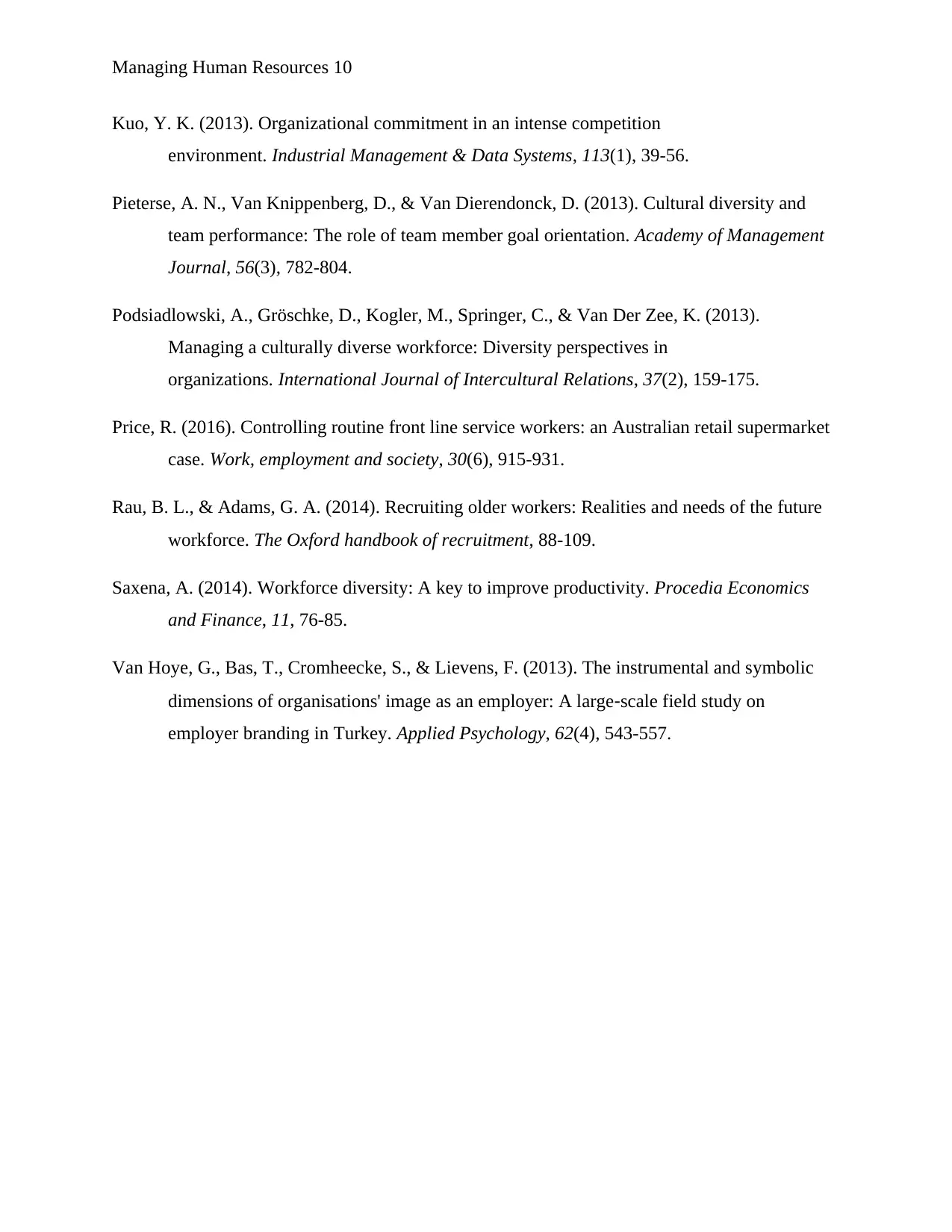
Managing Human Resources 10
Kuo, Y. K. (2013). Organizational commitment in an intense competition
environment. Industrial Management & Data Systems, 113(1), 39-56.
Pieterse, A. N., Van Knippenberg, D., & Van Dierendonck, D. (2013). Cultural diversity and
team performance: The role of team member goal orientation. Academy of Management
Journal, 56(3), 782-804.
Podsiadlowski, A., Gröschke, D., Kogler, M., Springer, C., & Van Der Zee, K. (2013).
Managing a culturally diverse workforce: Diversity perspectives in
organizations. International Journal of Intercultural Relations, 37(2), 159-175.
Price, R. (2016). Controlling routine front line service workers: an Australian retail supermarket
case. Work, employment and society, 30(6), 915-931.
Rau, B. L., & Adams, G. A. (2014). Recruiting older workers: Realities and needs of the future
workforce. The Oxford handbook of recruitment, 88-109.
Saxena, A. (2014). Workforce diversity: A key to improve productivity. Procedia Economics
and Finance, 11, 76-85.
Van Hoye, G., Bas, T., Cromheecke, S., & Lievens, F. (2013). The instrumental and symbolic
dimensions of organisations' image as an employer: A large‐scale field study on
employer branding in Turkey. Applied Psychology, 62(4), 543-557.
Kuo, Y. K. (2013). Organizational commitment in an intense competition
environment. Industrial Management & Data Systems, 113(1), 39-56.
Pieterse, A. N., Van Knippenberg, D., & Van Dierendonck, D. (2013). Cultural diversity and
team performance: The role of team member goal orientation. Academy of Management
Journal, 56(3), 782-804.
Podsiadlowski, A., Gröschke, D., Kogler, M., Springer, C., & Van Der Zee, K. (2013).
Managing a culturally diverse workforce: Diversity perspectives in
organizations. International Journal of Intercultural Relations, 37(2), 159-175.
Price, R. (2016). Controlling routine front line service workers: an Australian retail supermarket
case. Work, employment and society, 30(6), 915-931.
Rau, B. L., & Adams, G. A. (2014). Recruiting older workers: Realities and needs of the future
workforce. The Oxford handbook of recruitment, 88-109.
Saxena, A. (2014). Workforce diversity: A key to improve productivity. Procedia Economics
and Finance, 11, 76-85.
Van Hoye, G., Bas, T., Cromheecke, S., & Lievens, F. (2013). The instrumental and symbolic
dimensions of organisations' image as an employer: A large‐scale field study on
employer branding in Turkey. Applied Psychology, 62(4), 543-557.
1 out of 10
Related Documents
Your All-in-One AI-Powered Toolkit for Academic Success.
+13062052269
info@desklib.com
Available 24*7 on WhatsApp / Email
![[object Object]](/_next/static/media/star-bottom.7253800d.svg)
Unlock your academic potential
Copyright © 2020–2025 A2Z Services. All Rights Reserved. Developed and managed by ZUCOL.





